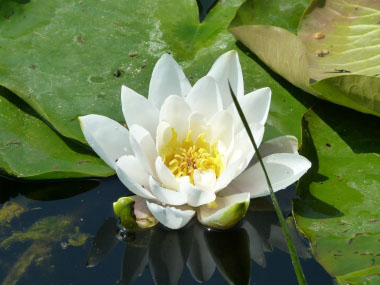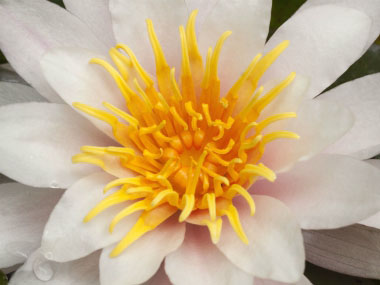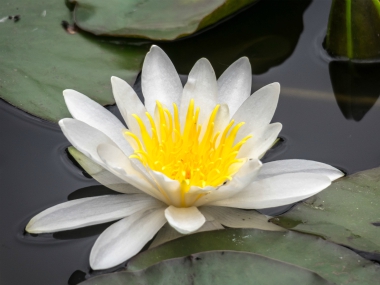





To support our efforts please browse our store (books with health benefits, etc.).
The white water lily is a perennial plant that is native to North America. This strong-rooted, attractive, aquatic plant has floating leaves. Water lilies (Nymphaea spp. and Nuphar spp.) are among the most primitive dicotyledons. The water lily’s flower floats on the surface but after flowering, the pedicel coils and drags the flower under water where the fruit develops. When the seeds are ripe and released they rice back to the surface. The seeds float with the help of an air-filled aril and are dispersed by waves and current. Eventually they sink and germinate.
Distinguishing Features
This water lily has a very distinct look and has spectacular fragrant flowers. The leaf pads are attractive, but toward the end of the growing season they can appear rather weathered. This species of water lily is very similar to Nymphaea tuberosa. Nymphaea tuberosa has slightly larger flowers; however, these lack fragrance. Also, the petals of its flowers are more blunt at their tips than those of the Nymphaea odorata.
Flowers
White water lily flowers have twenty to thirty white tapering petals and four sepals. They also have forty or more bright yellow stamens in the centre and a whorl of four green to purplish sepals at the base. The flowers measure 5 to 20 cm (2 to 8”) wide. The receptacle tapers abruptly towards the flower stalk. The anthers are deep yellow. The pistil is of several fused carpels. Flowers are fragrant and (like the leaves) float on the surface of the water. The flowers are usually open in the morning, but typically close by mid-afternoon and remain closed at night. Flowers from June to August depending on geographic location.
 Fields
of Nutrition has medicinal benefits and vitamin/mineral content of White Water Lily.
Fields
of Nutrition has medicinal benefits and vitamin/mineral content of White Water Lily.
Leaves
The leaves of white water-lily float on the surface of the water. They are nearly circular with a deep slit at the base. The blade of the floating leaves is 10 to 25 cm (4 to 10”) long, has smooth margins, is roundish or oval and long-stalked. Dark green and glossy in colour above and reddish-brown below. The submerged leaves have short stalks and a smooth blade. The leaves develop directly from the rootstock on long petioles. Its texture is rather leathery and thick. Fine veins radiate outward from the centre of the leaf. The long petiole of each leaf is terete and stout.
Height
This aquatic plant can range from 30cm to 2 m (1.5' to 6.5') in height (from its base in the water).
Habitat
White water lilies are found in slightly acidic-to-basic waters. Natural habitats for this aquatic plant include ponds, protected areas of lakes, and clear slow-moving rivers, particularly where dams (beaver or man made) have been constructed. This species of white water lily can be found throughout North America.
Edible Parts
Flower buds can be cooked as a vegetable or pickled. Young flowers and the leaves, according to PFAF, can be consumed raw. Leaves are usually cooked but become very limp. Used in soups and stews. Root is boiled or roasted. Although used as food for centuries, the main use of this plant has been medicinal. Native Americans used it as a herbal remedy for a variety of ailments, including colds, tuberculosis, bronchial complaints, and toothaches.
Other Name
White Lotus.
Similar Plants
Nymphaea alba.
Winter Survival Food Handbook

PDF Plant Magazines
Types of Wild Food
Geographic Zones Seasons
Disclaimer
EdibleWildFood.com is informational in nature. While we strive to be 100% accurate, it is solely up to the reader to ensure proper plant identification. Some wild plants are poisonous or can have serious adverse health effects.
We are not health professionals, medical doctors, nor are we nutritionists. It is up to the reader to verify nutritional information and health benefits with qualified professionals for all edible plants listed in this web site. Please click here for more information.
Why Edible Wild Food?
- Food costs are rising
- Free, wild food is readily abundant
- Wild food adds nutrition to your diet
- Wild food can help treat various medical conditions





